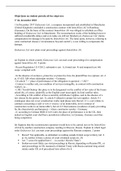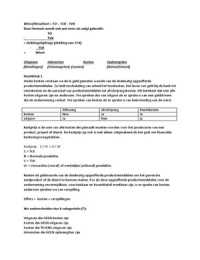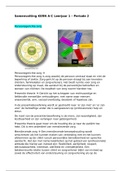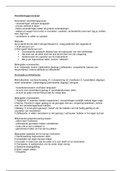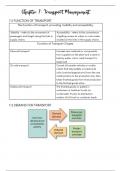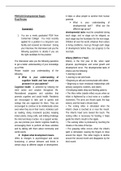GMAT Algebra: Fundamentals
Jeff Sackmann / GMAT HACKS
January 2013
Contents
1 Introduction 2
2 Difficulty Levels 3
3 Problem Solving 4
4 Data Sufficiency 15
5 Answer Key 21
6 Explanations 24
1
, Jeff Sackmann
www.gmathacks.com
1 Introduction
This document contains nothing but GMAT Algebra questions–100 of them, to
be exact. They are designed to build your skills on some of the most important
topics on the GMAT. Algebraic topics such as isolating a variable, solving a
quadratic, and managing exponents and roots are not only key components of
GMAT Algebra problems, but they underpin a wide range of questions from
word problems to geometry to number properties.
As in all of my GMAT preparation resources, you’ll find these questions
indexed by difficulty.
For further, more specific practice, I have produced several other resources
that may help you. Just about every subject covered on the GMAT has some-
thing to do with Algebra, but the group that has the most in common are Word
Problems. Many students find that translating Word Problems to Algebra is
one of the biggest challenges on the test. If you find yourself in that group, try
my ”Word Problems: Fundamentals” set, or give a try to ”Ratios, Rates, and
Percents,” which focuses solely on those three content areas.
Also, Total GMAT Math has several chapters (along with focused practice)
on Algebra and related issues, including individual chapters on fractions, deci-
mals, simplifying expressions, linear equations, systems of equations, quadratic
equations, inequalities, absolute value, exponents, roots, and more. If you find
you are struggling with the mechanics of these problems, your time is probably
better spent with the Total GMAT Math than in doing dozens and dozens of
practice problems, hoping to pick up those skills along the way.
There are plenty of articles at gmathacks.com to help you with your strategic
approach to GMAT Math questions. Most importantly, you should make sure
you understand every practice problem you do. It doesn’t matter if you get it
right the first time–what matters is whether you’ll get it right the next time you
see it, because the next time you see it could be on the GMAT.
With that in mind, carefully analyze the explanations. Redo questions that
took you too long the first time around. Review questions over multiple sessions,
rather than cramming for eight hours straight each Saturday. These basic study
skills may not feel like the key to GMAT preparation, but they are the difference
between those people who reach their score goals and those who never do.
Enough talking; there are 100 Algebra questions waiting inside. Get to
work!
2
Copyright 2008-13 Jeff Sackmann
www.gmathacks.com
, Jeff Sackmann
www.gmathacks.com
2 Difficulty Levels
In general, the level 5 questions in this guide are 500- to 560-level questions.
The level 4 questions represent a broad range of difficulty from about 380 to
500, while the level 3 questions are lower.
Easy (3)
PS
3, 17, 26
DS
66, 98
Moderately Easy (4)
PS
2, 5, 6, 8, 20, 24, 25, 28, 31, 34, 35, 36, 37, 41, 45, 47
DS
52, 55, 57, 59, 60, 62, 64, 65, 67, 68, 69, 71, 72, 73, 74, 76, 77, 81, 82, 83, 84,
85, 88, 89, 91, 92, 93, 94, 95, 96, 99
Moderate (5)
PS
1, 4, 7, 9, 10, 11, 12, 13, 14, 15, 16, 18, 19, 21, 22, 23, 27, 29, 30, 32, 33, 38,
39, 40, 42, 43, 44, 46, 48, 49, 50
DS
51, 53, 54, 56, 58, 61, 63, 70, 75, 78, 79, 80, 86, 87, 90, 97, 100
3
Copyright 2008-13 Jeff Sackmann
www.gmathacks.com
, Jeff Sackmann
www.gmathacks.com
3 Problem Solving
Note: this guide contains both an answer key (so you can quickly check your
answers) and full explanations.
3 2
1. If 6 − m =4+ n and m = 12 , then n =
(A) −8
(B) −2
(C) − 21
1
(D) 2
(E) 2
2. If x = − 13 , then 1 − x − x2 − x3 =
1
(A) 3
13
(B) 27
14
(C) 27
7
(D) 1 27
(E) 1 13
3. For a certain year, a charitable organization has set a fundraising
goal of $72,000, divided into 12 equal monthly allocations. If the
organization raised $20,000 in the first three months, by how
much has it exceeded its goal for the first three months?
(A) $200
(B) $400
(C) $600
(D) $1,100
(E) $2,000
4. If y 2 = 3z 3 and 2z = 4, what is the value of y 2 + z ?
√
(A) 2 √7
(B) 2( 6 + 1)
(C) 26
(D) 28
(E) 32
4
Copyright 2008-13 Jeff Sackmann
www.gmathacks.com
Jeff Sackmann / GMAT HACKS
January 2013
Contents
1 Introduction 2
2 Difficulty Levels 3
3 Problem Solving 4
4 Data Sufficiency 15
5 Answer Key 21
6 Explanations 24
1
, Jeff Sackmann
www.gmathacks.com
1 Introduction
This document contains nothing but GMAT Algebra questions–100 of them, to
be exact. They are designed to build your skills on some of the most important
topics on the GMAT. Algebraic topics such as isolating a variable, solving a
quadratic, and managing exponents and roots are not only key components of
GMAT Algebra problems, but they underpin a wide range of questions from
word problems to geometry to number properties.
As in all of my GMAT preparation resources, you’ll find these questions
indexed by difficulty.
For further, more specific practice, I have produced several other resources
that may help you. Just about every subject covered on the GMAT has some-
thing to do with Algebra, but the group that has the most in common are Word
Problems. Many students find that translating Word Problems to Algebra is
one of the biggest challenges on the test. If you find yourself in that group, try
my ”Word Problems: Fundamentals” set, or give a try to ”Ratios, Rates, and
Percents,” which focuses solely on those three content areas.
Also, Total GMAT Math has several chapters (along with focused practice)
on Algebra and related issues, including individual chapters on fractions, deci-
mals, simplifying expressions, linear equations, systems of equations, quadratic
equations, inequalities, absolute value, exponents, roots, and more. If you find
you are struggling with the mechanics of these problems, your time is probably
better spent with the Total GMAT Math than in doing dozens and dozens of
practice problems, hoping to pick up those skills along the way.
There are plenty of articles at gmathacks.com to help you with your strategic
approach to GMAT Math questions. Most importantly, you should make sure
you understand every practice problem you do. It doesn’t matter if you get it
right the first time–what matters is whether you’ll get it right the next time you
see it, because the next time you see it could be on the GMAT.
With that in mind, carefully analyze the explanations. Redo questions that
took you too long the first time around. Review questions over multiple sessions,
rather than cramming for eight hours straight each Saturday. These basic study
skills may not feel like the key to GMAT preparation, but they are the difference
between those people who reach their score goals and those who never do.
Enough talking; there are 100 Algebra questions waiting inside. Get to
work!
2
Copyright 2008-13 Jeff Sackmann
www.gmathacks.com
, Jeff Sackmann
www.gmathacks.com
2 Difficulty Levels
In general, the level 5 questions in this guide are 500- to 560-level questions.
The level 4 questions represent a broad range of difficulty from about 380 to
500, while the level 3 questions are lower.
Easy (3)
PS
3, 17, 26
DS
66, 98
Moderately Easy (4)
PS
2, 5, 6, 8, 20, 24, 25, 28, 31, 34, 35, 36, 37, 41, 45, 47
DS
52, 55, 57, 59, 60, 62, 64, 65, 67, 68, 69, 71, 72, 73, 74, 76, 77, 81, 82, 83, 84,
85, 88, 89, 91, 92, 93, 94, 95, 96, 99
Moderate (5)
PS
1, 4, 7, 9, 10, 11, 12, 13, 14, 15, 16, 18, 19, 21, 22, 23, 27, 29, 30, 32, 33, 38,
39, 40, 42, 43, 44, 46, 48, 49, 50
DS
51, 53, 54, 56, 58, 61, 63, 70, 75, 78, 79, 80, 86, 87, 90, 97, 100
3
Copyright 2008-13 Jeff Sackmann
www.gmathacks.com
, Jeff Sackmann
www.gmathacks.com
3 Problem Solving
Note: this guide contains both an answer key (so you can quickly check your
answers) and full explanations.
3 2
1. If 6 − m =4+ n and m = 12 , then n =
(A) −8
(B) −2
(C) − 21
1
(D) 2
(E) 2
2. If x = − 13 , then 1 − x − x2 − x3 =
1
(A) 3
13
(B) 27
14
(C) 27
7
(D) 1 27
(E) 1 13
3. For a certain year, a charitable organization has set a fundraising
goal of $72,000, divided into 12 equal monthly allocations. If the
organization raised $20,000 in the first three months, by how
much has it exceeded its goal for the first three months?
(A) $200
(B) $400
(C) $600
(D) $1,100
(E) $2,000
4. If y 2 = 3z 3 and 2z = 4, what is the value of y 2 + z ?
√
(A) 2 √7
(B) 2( 6 + 1)
(C) 26
(D) 28
(E) 32
4
Copyright 2008-13 Jeff Sackmann
www.gmathacks.com



